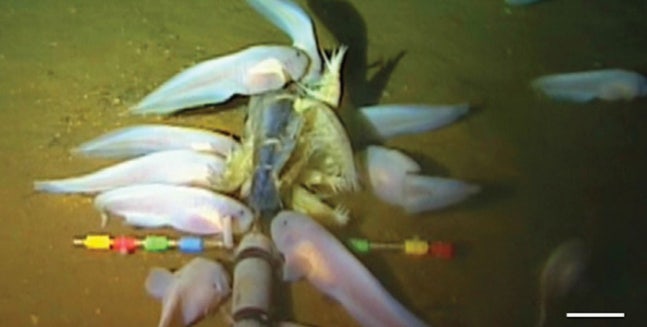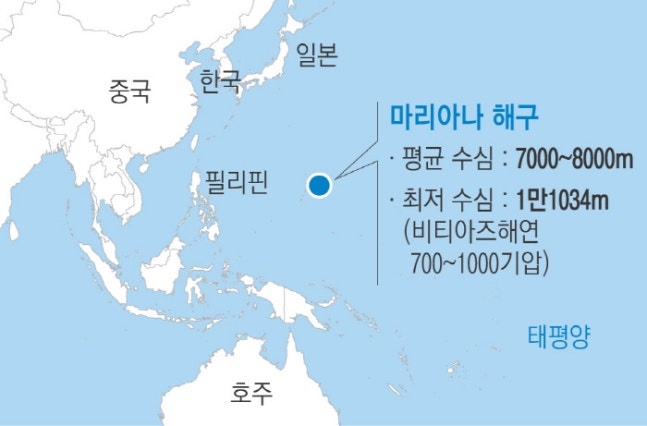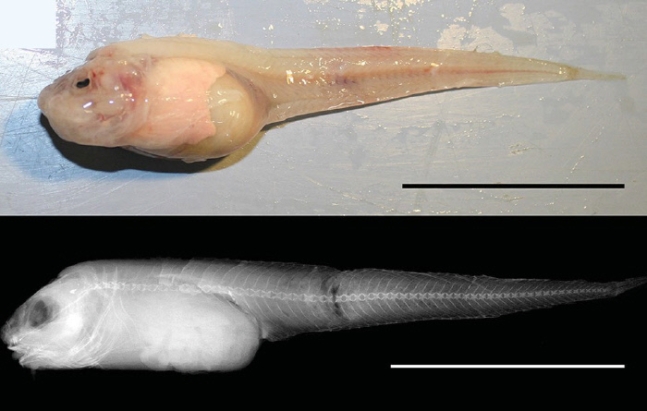Gene sequence from fish living in the Mariana Trench reveals clues to living life under pressure.
Hadal snailfish (Pseudoliparis swirei) gather around a baited instrument that researchers deployed in the Mariana Trench in 2014.Credit: SOI/HADES/University of Aberdeen/Dr. Alan Jamieson
A flabby, translucent creature called the hadal snailfish (Pseudoliparis swirei) is the first animal from the extreme depths of the ocean to have its genome sequenced. Its genetic road map is revealing the basis of adaptations that enable animals to live in hostile environments such as the Mariana Trench, the deepest place in the ocean.
Deep-sea creatures must cope with a cold, dark and extreme-pressure environment. But without the genome of any animal living below 6,000 metres — a region known as the hadal zone — scientists weren’t sure how the creatures acquired the adaptations necessary to survive. Results published on 15 April in Nature Ecology & Evolution1 point to skeletal and cellular changes on which the hadal snailfish relies to endure these harsh conditions.
Nothing quite like this study has ever been done before, says Paul Yancey, a marine biologist at Whitman College in Walla Walla, Washington. “It’s exciting.”
Living under pressure
The study authors captured hadal snailfish from about 7,000 metres down in the Mariana Trench in the western Pacific Ocean. After sequencing the fish’s genome, the team searched for clues that could explain hadal snailfish traits such as a skeleton made of cartilage and cellular membranes that keep working under immense pressures. The pressure in the Mariana Trench is similar to what someone would feel if the entire weight of the Eiffel Tower rested on their big toe.
The researchers compared the fish’s DNA to that of a close relative, the Tanaka’s snailfish (Liparis tanakae), which lives in tide pools. The two species split from a common ancestor about 20 million years ago.
There are several genetic changes in the hadal snailfish genome linked to a rapid adaptation to the deep sea, says Shunping He, an ichthyologist at the Chinese Academy of Sciences in Wuhan, and co-lead author of the study.
The high pressures in the Mariana Trench would crush normal bones. But a gene integral to hardening bones is inactive in the hadal snailfish — consistent with the idea that a skeleton made of cartilage is more pressure-tolerant, the authors write.
Hadal snailfish have also lost several genes involved in sensing light. However, He and his colleagues did find five such genes that are still active, suggesting that the fish might have a residual ability to see.
Some groups of genes, many of which are involved in fatty-acid metabolism, have expanded in the hadal snailfish. The presence of certain fatty acids helps cell membranes to stay flexible at great depths, the authors write. Otherwise, high pressure can cause those membranes to become rigid and impenetrable. Other genes act to prevent proteins from folding incorrectly under extreme pressure.
One of a kind?
It’s thrilling to see this genome sequence, as well as ideas about how vertebrates adapt to extreme depths, says Santiago Herrera, a molecular ecologist at Lehigh University in Bethlehem, Pennsylvania. “Understanding how this kind of life is possible in this environment is really ground-breaking.”
The study also creates a basis for future work looking at how fish have evolved to survive in extreme environments, says Natalya Gallo, an oceanographer at Scripps Institution of Oceanography in La Jolla, California. Now, researchers can conduct lab-based experiments with tools such as CRISPR, editing genes to explore the traits that they control, she adds.
It’ll be interesting to see whether the genetics behind hadal snailfish adaptations are representative of animals in the deep sea, or whether each species has its own set of genetic strategies to survive this extreme environment, Herrera says.
(원문: 여기를 클릭하세요~)
쇳덩이도 찌그러지는 해저 1만m ‘최상위 포식자’ 물고기가 사는 법

미국 워싱턴대 연구진이 마리아나해구에서 바다 밑으로 내려보낸 무인탐사기와 미끼에 마리아나 스네일피시가 모여든 모습. 아래 두 장의 사진은 연구진이 채집해 바다 위로 건져 올린 마리아나 스네일피시와 엑스레이로 촬영한 모습. 워싱턴대 제공
1000기압 이상의 암흑 세계…산소 농도 낮고, 수온은 1~4도
마리아나 스네일피시, 두개골 빈 공간이 체내 압력 조절 기능
2014년 첫 발견 …단백질 변성 막는 특수 물질도 다량 존재
북태평양 괌 인근의 마리아나해구는 평균 수심 7000~8000m로 지금까지 확인된 곳 중에서 가장 깊다.
특히 비티아즈 해연의 깊이는 1만1034m에 달한다. 700기압에서 1000기압에 달하는 수압 때문에 생태 조사가 거의 이뤄지지 않은 마리아나해구의 심해에서 2014년 발견된 ‘마리아나 스네일피시’(Mariana snailfish·마리아나 꼼치)는 과학자들을 놀라게 했다. 엄청난 수압을 견뎌내는 척추동물이 있을 것이라고는 아무도 예상하지 못했기 때문이다. 해저 7000~8000m에 사는 이 물고기를 연구한 과학자들이 최근 쇳덩어리도 찌그러지게 할 정도의 높은 수압을 견뎌내는 비결을 규명했다.

중국 서북공업대학 연구진은 마리아나 스네일피시가 심해에서 생존할 수 있는 이유 등을 포함한 논문을 지난 16일 국제학술지 네이처 생태와 진화(Nature Ecology & Evolution)에 게재했다.
연구진은 무인탐사기를 이용해 포획한 마리아나 스네일피시의 몸 구조와 유전자 등을 조사했다. 올챙이와 비슷하게 생긴 이 심해어는 꼼칫과로 길이는 최대 30㎝가량이다. 마리아나해구의 심해 먹이사슬에서 최상위 포식자로서 심해에 사는 다른 무척추동물들을 먹잇감으로 삼으면서 군림하고 있다.
연구진은 이 물고기가 극도로 높은 수압을 견뎌낼 수 있는 이유로 두개골 내에 빈 공간이 있다는 점을 꼽았다. 논문의 주저자인 서북공업대학 쿤 왕 박사는 내셔널지오그래픽과의 인터뷰에서 “이 빈 공간을 통해 체내와 체외 압력의 균형을 맞추는 것으로 보인다”고 설명했다. 마리아나 스네일피시에게 머리 내 빈 공간이 없다면 수압에 눌려 찌부러지게 될 것이란 얘기다.
뼈가 단단한 어종에 속함에도 체내의 뼈 대부분이 연골로 이뤄진 사실도 확인됐다. 연구진은 마리아나 스네일피시의 유전자 가운데 석회화를 담당하는 유전자에 변이가 일어나 이 유전자가 기능을 다하지 않는 것으로 나타났다고 설명했다. 석회화란 칼슘이 뼈에 침착돼 뼈가 단단해지는 것을 말한다. 즉 마리아나 스네일피시는 자신이 속한 꼼칫과의 어류들과 달리 뼈가 유연하기 때문에 높은 수압을 견뎌낼 수 있다는 얘기다.

이 물고기가 처음 발견된 것은 2014년으로 당시 미국 워싱턴대 등 연구진은 고등어를 미끼로 단 탐사장비를 해저에 내려보내 촬영했다. 수심 7000m가량까지 장비를 내려보내는 데 4시간이 걸렸다. 연구진이 채집한 마리아나 스네일피시는 연분홍색 피부에 내장이 보일 정도의 반투명한 모습이었고, 비늘이 없는 것으로 확인됐다. 당시 연구진이 채집해 건져올린 마리아나 스네일피시는 수심 7966m에서 잡혔다. 촬영된 곳 중 가장 깊은 곳은 수심 8143m 지점이었다. 연구진은 이 물고기를 바다 위로 건져올리자 바로 녹아내리듯이 흐물흐물해졌다고 밝힌 바 있다. 극도로 높은 수압이 오히려 이 물고기에게는 몸이 유지되도록 도와주는 요소였던 것이다.
마리아나해구는 지구상에서 생물에게 가장 가혹한 환경으로 꼽힌다. 높은 수압과 빛이 전혀 들지 않는 암흑 외에도 1~4도 정도에 불과한 낮은 수온과 낮은 산소 농도, 부족한 먹이 자원 등 생존에 부적합한 요소들로 가득하기 때문이다.
극한 환경 때문에 인간이 직접 탐사한 기록도 드물다. 현재까지 인류가 세운 필리핀과 괌 사이의 마리아나해구 탐사 기록 중 가장 깊이 내려간 건 1만911m까지다. 1960년 미국 해군 장교 돈 월시와 스위스 기술자 자크 피카드가 잠수정 트리에스테를 타고 내려갔다. 다음으로는 터미네이터, 아바타 등의 영화로 유명한 제임스 캐머런 감독이 2012년 잠수정 딥시챌린저를 타고 챌린저해연에서 세운 1만898m다. 당시 캐머런 감독은 2시간36분 동안 해저로 내려가 3시간가량 심해를 촬영한 뒤 바다 위로 돌아왔다. 그가 탄 잠수정은 1125기압을 견딜 수 있는 64㎜ 두께의 강철로 만들어진 것이었다.
서북공업대 연구진은 마리아나 스네일피시의 체내에서 단백질이 유지되는 이유도 확인했다. 수압이 극도로 높기 때문에 체내 단백질이 변성되는 것을 막아주는 물질이 체내에 다량으로 존재하는 게 드러났다. 연구진은 ‘트리메틸아민엔옥사이드(TMAO)’라고 불리는 이 물질이 단백질을 안정시키는 역할을 담당하고 있다고 설명했다. 체내의 단백질 중 세포 간 물질 이동을 돕는 단백질도 확인됐다. 높은 수압하에서는 세포막을 통해 물질이 교환되기 어려울 수 있는데 마리아나 스네일피시의 체내에서는 생존에 필요한 물질을 운반하는 역할의 단백질이 대량으로 생성되고 있었다는 것이다.
연구진은 마리아나 스네일피시가 무인탐사기의 조명에 전혀 반응하지 않았다고 밝혔다. 빛이 전혀 들지 않는 환경에 서식하고 있어 시각이 퇴화돼 있기 때문이다. 연구진은 “빛의 자극에 반응하는 광수용체 관련 유전자 가운데 중요한 기능을 하는 유전자들이 이 물고기의 체내에 존재하지 않는 것으로 보인다”며 “빛을 감지할 필요가 전혀 없는 환경에 서식하기 때문”이라고 설명했다.
(원문: 여기를 클릭하세요~)
